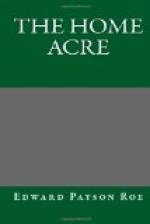Be hospitable to birds, the best of all insect destroyers. Put up plenty of houses for bluebirds and wrens, and treat the little brown song-sparrow as one of your stanchest friends.
A brief word in regard to the quince, and our present list of fruits is complete.
If the quince is cultivated after the common neglectful method, it would better be relegated to an obscure part of the garden, for, left to itself, it makes a great sprawling bush; properly trained, it becomes a beautiful ornament to the lawn, like the other fruits that I have described. Only a little care, with the judicious use of the pruning-shears, is required to develop it into a miniature and fruitful tree, which can be grown with a natural rounded head or in the form of a pyramid, as the cultivator chooses. It will thrive well on the same soil and under similar treatment accorded to the pear or the apple. Procure from a nursery straight-stemmed plants; set them out about eight feet apart; begin to form the head three feet from the ground, and keep the stem and roots free from all sprouts and suckers. Develop the head just as you would that of an apple-tree, shortening in the branches, and cutting out those that interfere with each other. Half a dozen trees will soon give an ample supply. The orange and the pear shaped are the varieties usually recommended. Rea’s Mammoth is also highly spoken of. Remember that the quince equally with the apple is subject to injury from the borer, and the evil should be met as I have already described.
There is a natural wish to have as much grass about the dwelling as possible, for nothing is more beautiful. If there are children, they will assuredly petition for lawn-tennis and croquet grounds. I trust that their wishes may be gratified, for children are worth infinitely more than anything else that can be grown upon the acre. With a little extra care, all the trees of which I have spoken can be grown in the spaces allotted to grass. It is only necessary to keep a circle of space six feet in diameter—the trunk forming the centre—around the tree mellow and free from any vegetable growth whatever. This gives a chance to fertilize and work the ground immediately over the roots. Of course vigorous fruit-trees cannot be grown in a thick sod, while peaches and grapes require the free culture of the garden, as will be shown hereafter. In view, however, of the general wish for grass, I have advised on the supposition that all the ornamental trees, most of the shrubs, and the four fruits named would be grown on the portions of the acre to be kept in lawn. It may be added here that plums also will do well under the same conditions, if given good care.
Grass is a product that can be cultivated as truly as the most delicate and fastidious of fruits, and I had the lawn is mind when I urged the generous initial deep plowing and enriching. Nothing that grows responds more promptly to good treatment than grass; but a fine lawn cannot be created in a season, any more than a fine tree.




